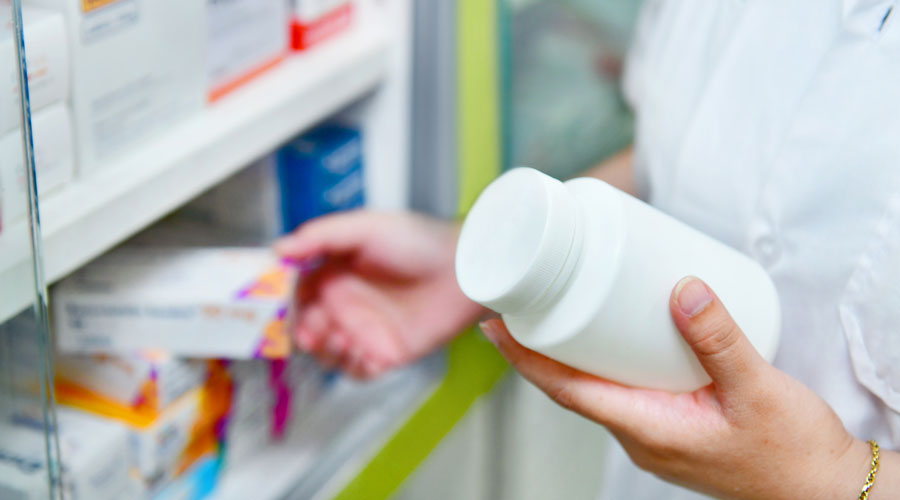Inside: Everything you need to know about marketing your pharmacy to earn more business.
In an ideal world, doing your job well would be enough for your pharmacy to succeed, but as it is, you need to market your business and build awareness of your brand.
Marketing is actually a service to your patients — it’s the means of informing them about what you offer them and what benefits they can get from you. It’s good for you and it’s good for them.
There are seemingly endless ways to market your pharmacy, and not all are equally appropriate or effective. The possibilities can be overwhelming for small businesses. That’s why we’ve put together a total guide on pharmacy marketing to serve as your go-to resource.
Read on for a complete guide to all the ways you can get the word out about your pharmacy.
Digital Marketing
People now spend more time online than they do watching television, so if you are not marketing to your patients in the digital space, you’re missing out on a major opportunity.
Your pharmacy needs a digital presence both to maintain connections with your current patients and reach new ones. The good news is that digital marketing is often free or low cost, and you can target audiences with pinpoint precision.
Here are all the ways you should be connecting with patients digitally.
Website
Your website is the face of your pharmacy on the internet, so you should make sure it’s leaving a great first impression. Invest in an attractive design that matches up with the branding you have inside your store.
But it’s more than just looks — you also need to have compelling text that conveys what you have to offer patients. Once you’ve convinced people to stay on your site, make sure it is easy to navigate. Your site should have pages like:
- About Us
- Services
- FAQs
- Contact Us
If you want to go above and beyond with your site, you can also create a blog, which gives you the opportunity to engage in content marketing. Content marketing is when you subtly promote your products and services by demonstrating how useful and relevant they can be instead of making a hard pitch. Your patients get helpful and usable information, and you can get the word out about your products.
Search engine optimization
By perfecting your website’s search engine optimization, you can help new patients to find your pharmacy.
While it seems like a highly technical undertaking, search engine optimization really boils down to using strategic keywords that help to elevate your website to the top of search engine results.
To make your pharmacy more attractive to search engines, make sure your website is well-organized and informative. It should include information like where you are located and what kind of services you provide, so if someone is searching for “Compounding Pharmacy in St. Louis,” the search engine will point them in your direction.
Each page of your website should have a title and description that contain keywords that are unique and relevant to your pharmacy. While there are countless tips and tricks to SEO, having clean and descriptive text on every page of your website is a great starting point to making your store more findable on search engines.
Email marketing
Marketing emails can inform patients about what’s going on in the pharmacy at a low cost. To create a successful email campaign, you have to be proactive about collecting email addresses from your patients.
You can have them sign up when they are checking out at the pharmacy, fill out a form on your website or app, and fill out a sign-up sheet at health fairs and community events.
Your emails should look professional and have consistent branding. By using an email marketing service, you can create polished designs and keep track of important analytics like how many people opened emails or clicked on them.
As for what to send to your patients, you can use email for:
- Targeted messages
- E-Newsletters with helpful health tips and pharmacy news
- Promotions and sales
- Welcome messages
- Loyalty rewards updates
Send emails regularly, but don’t crowd your patients’ inboxes. Check your analytics to find the right balance — if your open rates are decreasing and unsubscribe rates are increasing, that’s a sign you could be sending too many messages.
Be sure that you’re following the CAN-SPAM Act, which gives recipients the ability to opt out of emails.
More articles on marketing
 How to Use Analog Marketing to Earn More Pharmacy Business
How to Use Analog Marketing to Earn More Pharmacy Business
 25 Irresistible Pharmacy Promotion Ideas to Get More Patients
25 Irresistible Pharmacy Promotion Ideas to Get More Patients
 Mark Your Calendar: A Promotions Checklist for Pharmacies
Mark Your Calendar: A Promotions Checklist for Pharmacies
Social Media Marketing
In this day and age, a strong social media presence is a necessity for successfully marketing your pharmacy. It’s a cost-effective way to increase awareness of your store within the community, drive traffic to your website, communicate with patients, and build your brand.
While there are countless social media platforms where you can build a presence, Facebook and Twitter remain stalwarts. Here’s how to use both of them to your advantage.
In order to get the most out of Facebook, you should create a business page for your pharmacy, not an individual profile. Put as much information on your page as possible so people who find you through Facebook can get a complete picture of your pharmacy without having to search anywhere else.
Post engaging content on a regular basis to make sure you are making it onto people’s timelines — you can even schedule batches of posts ahead of time to stay on top of posts.
If you have a regular posting schedule and interact with people who comment on your posts, you can reach new eyes organically without spending any money at all.
Take full advantage of the Page and Audience Insights that Facebook offers. This will help you figure out who’s seeing your posts and what people in your area are interested in so that you can target your content to make it even more effective.
With a Twitter profile, you can reach a different set of potential patients than with Facebook. Twitter users are especially eager to find out about new things, making it ideal for growing your business.
The key to creating a successful Twitter presence is to post often and develop a distinct brand voice. Use hashtags to host conversations with your followers and jump on relevant trending hashtags to drive more traffic to your website.
Pin the most important information about your pharmacy to the top of your Twitter profile so people visiting the page can see if you are having a sale or debuting a brand new service without having to scroll through all your tweets.
Digital ads
The old-fashioned approach to online advertising is the pay-per-click model. This is when an ad for your pharmacy pops up when a user searches something related online, and you pay every time someone clicks on that ad. Pay-per-click can be effective in getting the word out, but it is one of the more expensive forms of online advertising.
A lower-cost digital advertising option is advertising on social media. You can pay to sponsor posts so that your accounts are more prominently featured in Facebook feeds and Twitter timelines and appear to more than just the people who follow you.
Banner ads can also be a relatively inexpensive online advertising option. Contact local media outlets for their online ad rates and your pharmacy can have a place on their website just like you would take out a spot in the local print paper.
Online reviews
Nearly 90 percent of consumers read online reviews before they visit a business, so what your patients are saying about you on review websites like Google and Yelp can be a big boost for your pharmacy.
Good reviews are essentially free advertising, and the best way to get reviews is to ask patients to leave them. After you’ve received a compliment from a patient, let them know that the best way to show their appreciation is to leave an online review.
When you receive a poor review, that’s free advertising too — just not the good kind. You can counteract the effect they have by responding with a thoughtful, genuine response. It shows readers that you care about customer service.
Mobile outreach
The vast majority of your patients are always carrying around a smartphone, and you can be wherever they are when you embrace mobile marketing. It can be as simple as sending refill and pickup reminders via text message, or you can go full-speed ahead by creating a branded mobile app for your store.
With an app, patients can do more than arrange for refills. Apps also allow patients to:
- Receive push notifications
- Find out about ongoing sales and promotions
- Get app-exclusive coupons
- Manage loyalty program
- Update their profiles
- Read breaking health news
In addition to an app, you should make sure your website has a responsive design that looks good on both a desktop and a phone. Even folks who don’t use your app may visit your site on their phone, so it should be easy to read and use on any platform.
Print Marketing
While digital advertising is the focus of most marketing efforts these days, traditional ad mediums can still make an impact, and print is not yet dead.
Analog or traditional advertising, while less common nowadays, is seen as more trustworthy and is more memorable than digital advertising.
Consider adding these print efforts to your marketing strategy for a well-rounded campaign.
Direct mail
It may seem old fashioned to send marketing materials via snail mail, but direct mail marketing has its perks.
For one, people get countless emails every day but only a few pieces of mail, so your message is more likely to break through the noise. They’re also more likely to keep your postcard around the house, meaning it’s more memorable than an email that gets immediately deleted.
To get the most out of your direct mail campaign, use mailing lists to target your ideal patients. After you send your mailers, follow it up with an email to remind people about your pharmacy. And of course, make sure that the mailers you send out look great. If the design is sloppy, direct mail could hurt your pharmacy’s reputation rather than help.
Newspapers and magazines
Even though print newspaper and magazine circulation have been declining in the wake of the internet, you shouldn’t abandon print advertising. Declining circulation has actually made print ads much more affordable.
Plus, print readers are more engaged than those browsing online, which means you’re more likely to capture their attention. And print ads are still one of the best ways to reach seniors, who are the biggest spenders at your pharmacy.
Keep in mind the audience for your print ads — advertise in local publications to make sure you’re reaching the right people. Depending on the size of your community, there could be multiple specialty publications and periodicals to advertise to niche groups.
For newspaper ads, Sunday is the best day to take out an ad. For magazines, aim to secure a spot in a high visibility part of the publication like the back page or inside of the front cover.
In-Store Marketing
When your patients are inside the pharmacy, they are a captive audience, making the store itself a potent marketing vehicle. They can’t just delete a marketing email or throw away a mailer.
Use the time patients spend shopping to remind them of all that you have to offer them. The best in-store marketing will be tailored to the way patients move around the store and will make them feel like they are getting a good deal on products or services.
Signage
Well-placed signs can inform patients about what you have to offer and improve the in-store experience. Your store doesn’t need to be papered with marketing information — signs in key spots like your window and the checkout counter are ideal for advertising current promotions and seasonal services like flu shots.
Digital signs can attract patients’ attention and get more messaging across. If you invest in a monitor, you can rotate through ads for products and services and show off great reviews you’ve received on social media.
Bag inserts
Bag slips are a fantastic, inexpensive way to market to your existing patients. A well-done bag insert will have a unique message that they aren’t getting from your other marketing. They should also line up with your current branding and have a clear value to the patient so they don’t just feel like garbage.
You can use bag inserts to make announcements, share brochures with details about services, inform patients about health and wellness resources, request online reviews, or give them a coupon for their next visit.
Compelling displays
To call attention to certain products, put them in flashier displays throughout your pharmacy. Products placed in end caps sell better than products in the aisle because they are highly visible and more accessible to patients.
You can also set up stations where patients can try products out in the store. If they try out a scented lotion or a fancy pen, they may add it to their basket even if it wasn’t on their list. And because they’ve paused to sample something, they’ll be encouraged to look around at everything else on the shelf.
Free wi-fi
Patients who are contending with data limits will be eager to log in to free Wi-Fi while they are shopping at the pharmacy, but it’s not a favor on your part — it’s a marketing opportunity in disguise. Create a landing page that informs them about special deals or services, which they have to look at before they start browsing the web.
You can also ask for patients’ email addresses when they log in, which you can add to your database for future email marketing.
Great customer service
Your staff members are some of the best brand ambassadors that you have, so be prepared to make the most of one-on-one interactions with patients.
Being friendly and knowledgeable can go a long way in enhancing the store’s reputation. And if you take the time to listen to patients, when you recommend appropriate products and services, it won’t feel like a sales pitch. Instead, they’ll be impressed with the personalized service.
Community Involvement
The biggest advantage you have as a community pharmacy is that you actually know your community. The face time you have with patients both at the store and outside of it is something the national chains can’t compete with.
By getting out from behind the pharmacy counter, you have a chance to win over new patients and improve the reputation of your store within your community.
Here are a few ways you can get involved and get your name out there.
Participate in events
Whenever you have the opportunity, participate in community events. Whether it’s a 5K fundraiser or local health fair, you can show your patients that you care about the same things that they care about, all while promoting your products and services.
Set up a booth and bring branded freebies to give out to the people who stop and visit you. Make sure you wear clothes that have your pharmacy’s branding, too.
To go the extra mile, you can host a community event to introduce new folks to your store with a fun get together like:
- Health workshops
- Business block parties
- Holiday events
- Fundraisers
- Community advocacy
Sponsorships and partnerships
By sponsoring local sports teams, your pharmacy can show support for the community and advertise at the same time.
If you provide jerseys, you can put your pharmacy’s logo on the back. If you pay for field and equipment fees, you may earn a banner near the playing field.
In addition to sponsorships, you can also reach out to other locals to form partnerships. Work with other small businesses to support patients and each other. For example, you could partner with a florist to send bouquets to patients who have recently been released from the hospital. Or you could join forces with a mattress store to help patients resolve sleep issues.
These types of partnerships don’t just raise your profile with patients — they help strengthen your connection with other local business owners.
Give back
Donations and volunteer work can go a long way in building your pharmacy’s reputation in the community.
Support local causes by promoting them on your social media accounts. Pick a charity every month and ask patients if they want to “round up” their purchase to give back, or donate a percentage of sales.
You can show how committed you are to local causes by committing time to volunteer efforts. Your pharmacy staff could work together to help out the local food pantry, rec center, or after school program.
If you want to do even more, you can start your own community outreach program. Or you can serve on a community board for schools, non-profits, foundations, or neighborhood associations. In that position, you can shape your community into a healthier place to live.
Referral program
Every satisfied customer you have is a potential ambassador for your brand, and potential patients are more likely to give your pharmacy a try if they hear about it from a friend or family member. That’s why you need to do everything in your power to encourage referrals.
People are more likely to refer a friend if it benefits them in some way. To incentivize referrals, reward patients with a 10 percent discount on over-the-counter products if someone they referred visits the pharmacy.
You can even hold a contest for patients to see who can refer the most people. If someone refers five people, reward them with a free branded product, and gift the person who referred the most people with an even more tantalizing prize, like a $100 gift card.
Other Advertisement Mediums
Television
TV ads can bring small businesses a high return on investment, according to recent research by the marketing company Data2Decisions.
For your first television ad, it’s best to keep it short — 30 seconds or less. Make the messaging about your pharmacy and its values rather than specific products and services. Once you’ve built awareness, you can get more specific about what you have to offer.
Make sure to update your ads seasonally, so folks aren’t seeing the same ad for your pharmacy for years on end.
Radio
The majority of Americans still listen to terrestrial radio, even in the age of Spotify. Baby Boomers — your most lucrative customers — spend the most time listening.
Radio ads typically have 15, 30, and 60 second run times. Longer ads are the most effective, but a shorter ad means you can run it more frequently. The best time to run an ad on the radio is during peak commute hours, when most people are sitting in their cars.
Since you’re no sound engineer, your best bet for a memorable ad is to hire someone to put it together for you, but if you’re worried about the expense, radio hosts can also read a script that you’ve written.
You can also make a splash on the radio by appearing as a guest on a local radio show to answer listeners’ health and wellness related questions.
Outdoor
Even when your patients decide to disconnect from the news or their phone, you can still reach them with outdoor advertising.
The major perk of outdoor advertising is that it’s consistently there — it can’t be thrown away or deleted. If your patient drives the same route every day or takes the same bus, they’ll have repeated exposure to your ads.
Here are a few places where you can advertise outdoors:
- Billboards
- Benches
- Bulletin boards
- Buses
- Posters
Outdoor ads are often only looked at for a few seconds at a time, so you have to tailor your message accordingly. Keep the messaging short and sweet and make sure to include large colorful graphics.
Good places to advertise include high traffic areas, near your competitors, and near hospitals or clinics where patients are receiving prescriptions.
Other Things to Consider
Once you’ve decided what your most effective marketing channels will be, your work isn’t done.
Take these facts into consideration as you embark on your marketing journey.
Have a strategy
Before you go spending money on ads willy-nilly, you need to create a marketing plan.
The first step is to identify your target market. Define the potential patient that you’d like to reach — their age, income, and where they live. If you’re not sure who that is, look at your current patients to help you paint a picture.
Then, set an objective. What do you want to accomplish with your marketing campaign? You might want to gain new patients or increase sales. Whatever your objective is, make sure that it’s a specific goal that you can measure.
Plan where you want to advertise and, importantly, how much money you want to spend. If you don’t keep careful track of your budget, you will have a hard time telling if you got a good return on investment and may end up spending more than you wanted to.
By having a plan in place, you can measure if your marketing is working. If you don’t meet your set objectives, it’s a sign to change course.
Test your message
You can never know for sure what message is going to resonate with your patients. By performing testing, you can see what messaging is the most successful.
An A/B test is designed to help you figure out what kind of marketing works best for your patients. To perform an A/B test, you’ll have to create two different marketing messages and send them out to two different groups of people. Then, you’ll analyze which message performed better and use that information to guide your marketing decisions in the future.
When you do the test, pick one metric to help you measure success. You could measure email open rates, visits to your website, or enrollment in a service. Whatever metric you choose, make sure you can keep tabs on which message brought patients there.
Hire someone
There are so many moving parts to a marketing campaign that the task can eat up valuable time you could be spending with patients.
If it’s within your budget, consider hiring someone to help out with the marketing. This could mean hiring an outside marketing company or creating an in-house marketing position. Whoever you hire will be able to craft compelling messages, create beautiful branding, and keep track of successes so you can devote your time to patients and other important management tasks.
Just because you can do marketing yourself doesn’t mean you should, and hiring someone with a marketing background will give your pharmacy a more polished and professional reputation.
A Member-Owned Company Serving Independent Pharmacies
PBA Health is dedicated to helping independent pharmacies reach their full potential on the buy-side of their business. Founded and owned by pharmacists, PBA Health serves independent pharmacies with group purchasing services, wholesaler contract negotiations, proprietary purchasing tools, and more.
An HDA member, PBA Health operates its own NABP-accredited secondary wholesaler with more than 6,000 SKUs, including brands, generics, narcotics CII-CV, cold-storage products, and over-the-counter (OTC) products — offering the lowest prices in the secondary market.















